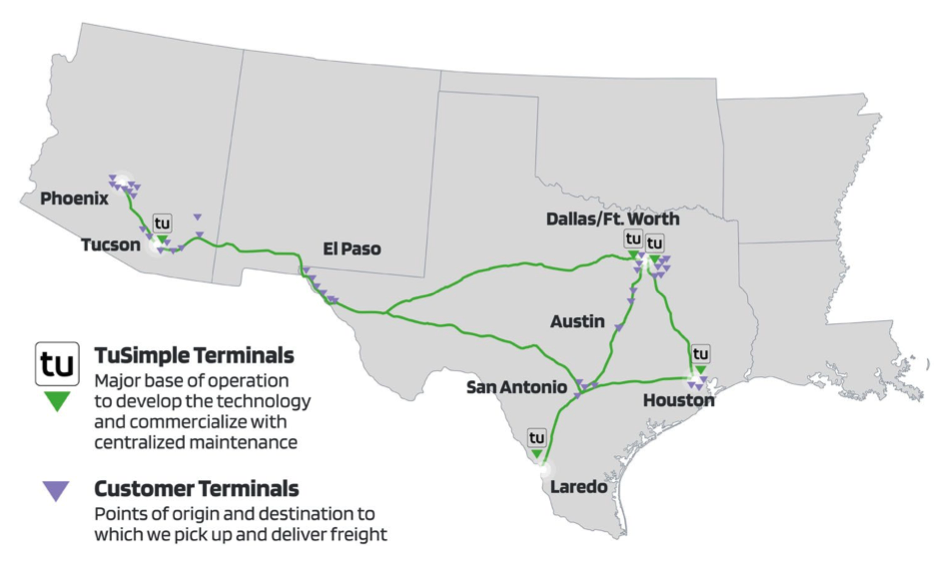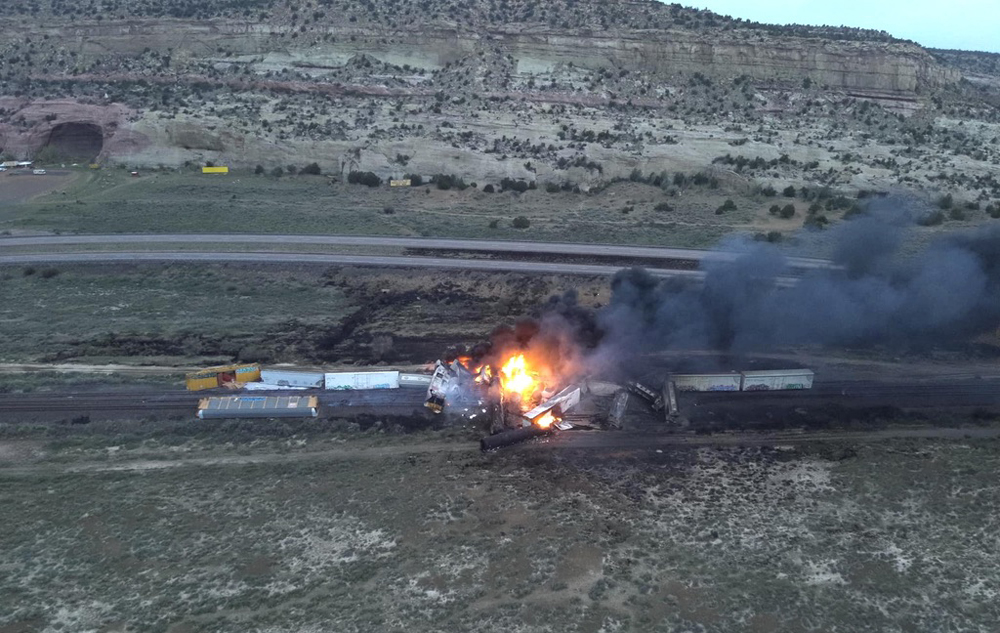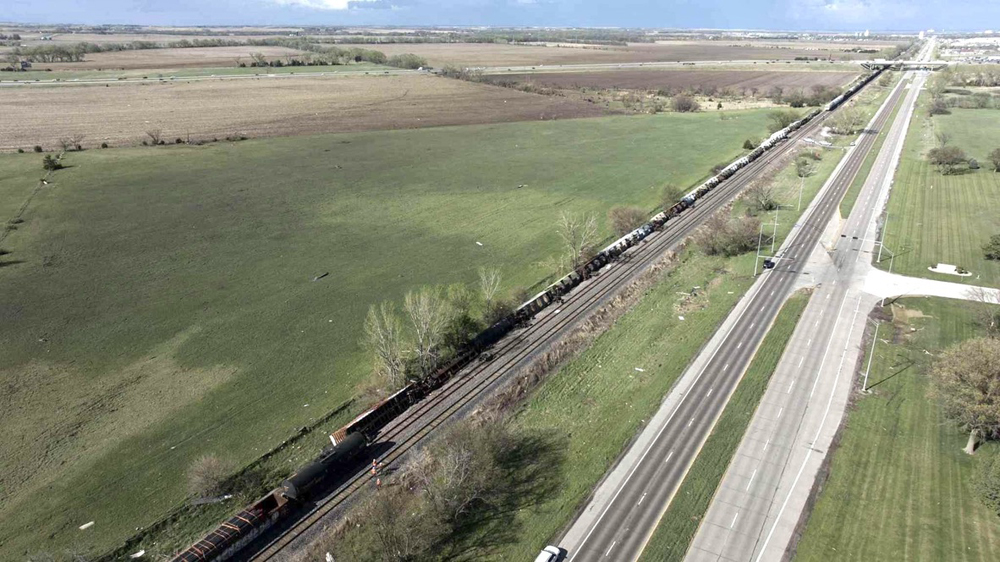
SAN DIEGO – Union Pacific and autonomous trucking company TuSimple have delayed plans to begin driverless truck moves between the railroad’s Tucson intermodal terminal and the Phoenix area.
The companies in February said they’d launch the service this spring. But the service has been pushed to the third quarter because TuSimple and UP have shifted their focus to hauling containers, rather than trailers as initially envisioned, TuSimple executives said during the company’s earnings call on Tuesday.
UP will become the first customer to move freight on TuSimple’s fully automated trucking route between the Tucson and Phoenix metro areas. UP subsidiary Loup Logistics will coordinate the moves between rail and the first and last mile.
TuSimple, which conducted its first driverless revenue move in December, operates a network of autonomous trucking routes in the Southwest. Previously the company made revenue moves with a “safety driver” aboard to take the wheel if necessary.
TuSimple says global supply chain problems have forced it to delay production of an autonomous rig that Navistar will build in Mexico. The companies planned to begin building the Level 4 autonomous rigs in 2024, but now are aiming for 2025.
Commercialization of TuSimple’s autonomous freight network does not depend on production of the Navistar rigs, the company says. Rather, it will continue to rely on rigs retrofitted with TuSimple technology.
UP invested in TuSimple in 2020. Canadian National also has invested in the autonomous trucking startup.














Good!
If the railroads shift all the freight to autonomous trucks, no one will feel safe to drive cars on the highways and the rails will be empty so passenger trains will have track available to carry us.
How does this automation handle backing into the dock between two trailers? And how does it handle a “drop & hook”? Asking for a friend…
Last mile is done by human drivers
My question is why isn’t UP just taking the loads by rail to Phoenix????
I would surmise because there are not enough containers going there to run a super long train
In the long term where easily feasible why pay for building and maintaining your own right of way and pay taxes on it when you can use subsidized right of way? And pay much less in direct labor costs to boot!
Yes that’s the problem: The subsidized right of way, read interstate highways and local arterials the truckers generally and TuSimple in particular have zero responsibility for designing, building, operating, or maintaining. That “gravy train” the truckers, and the intercity bus lines for that matter, needs putting an end to. Make ‘em pay for the wear and tear they inflict on those roads. Either that or we let the railroads off the hook for paying property taxes on their ROWs. Regarding UP’s alliance with TuSimple, in view of that railroad’s addiction to PSR I cannot help but think their medium to long-term goal is to pave over their ROWs for TuSimple.
UP doesn’t have a intermodal ramp in Phoenix anymore.
Problems will probably occur because humans will be involved with programming the operation and we know that no mistakes can happen there.
what’s wrong with not having automation anyway ?
$$$
For everyone that has replied above: did you not read that TuSimple ALREADY operated their first DRIVERLESS delivery in DECEMBER 2021. That means they’ve now been doing driverless route(s) for at least 4 months. Has anyone seen a national news story with one of these vehicles being involved in a crash? You haven’t, and there’s a reason you haven’t…there hasn’t been one. Which also means the carrier is already insured, otherwise they couldn’t haul freight in the first place. Just a little searching on the internet would’ve answered all your questions…including the difference between delivering a truck trailer and a container(yes, there is one, but I’m not going to tell you, it should be fairly easy to figure it out yourselves).
Gerald there is a HUGE difference between the traffic density on the highways out in the Southwest and most of the rest at of the country. But maybe you didn’t read the article close enough understand where they are operating right now. But let’s just wait till all the carnage begins and that’ll prove what a bad idea driverless truck will be.
There’s been at least 2 accidents already. One on 9/2019 and one on 4/2022. Both were conveniently buried so that’s why you’ve never heard about any.
Easy question. Will insurance carriers insure the truck (State Farm, Geico, Progressive, etc.)? If so, let them on the highways. If not, then no.
By the way, in case of a tort judgment, there are degrees of negligence against the insurance company. Driving while talking on the cell phone is one kind of negligence. Send a truck down the highway without a driver is another kind of negligence. Ditto, criminal cases. If a driverless truck causes a crash, I would assign the highest civil liability, AND, throw anyone who had anything to do with it in jail on felony charges.
In general, Insurance companies will insure most anything for an appropriate premium that is commensurate with the risk. So the real question is, how much will those premiums be?
I went through Atlanta this past weekend and the traffic was crazy as usual. It’s difficult for me to believe that a driverless truck will be able to navigate its way through that kind of mess. Sharing the highways with the ever increasing number of trucks is already dangerous. Driverless rigs will just make it worse in my opinion.
Tesla automobiles already do this admirably, so the technology is more than capable of handling slow, heavy traffic.
They have shifted their focus to hauling containers rather then trailers. There’s that big of a difference between a container and a trailer? Doesn’t a container sit on a trailer? Or are they having some other type of a problem they don’t want to talk about? Just seems strange.
No, there’s no difference pulling a container. The thing under the container is called a chassis. Maybe it has to do with getting the chassis is one area and the container in another.
I still think one bad accident with a driverless truck will push its deployment back many years. Multiple ones will sink it.
I’d like to think so. But look at the early days of jet airliners. Plenty of carnage, but people moved on.
Of course we didn’t have the litigious society that we have now, so maybe a couple of billion dollar lawsuits will do it in.
There’s been at least 2 accidents already. One on 9/2019 and one on 4/2022. That’s probably why this launch was delayed.